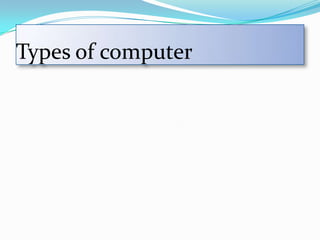
Introduction of computer
- 2. A computer is a general purpose device that can be programmed to carry out a finite set of arithmetic or logical operations. Since a sequence of operations can be readily changed, the computer can solve more than one kind of problem. Conventionally, a computer consists of at least one processing element, typically a central processing unit (CPU) and some form of memory. The processing element carries out arithmetic and logic operations, and a sequencing and control unit that can change the order of operations based on stored information. Peripheral devices allow information to be retrieved from an external source, and the result of operations saved and retrieved.
- 3. Types of computer Computers Analog Digital Hybrid Super Mini computer computer Micro Main frame computer computer
- 4. Analog computer Analog computer An analog computer is a form of computer that uses the continuously changeable aspects of physical phenomena such as electrical, mechanical, or hydraulic quantities to model the problem being solved. In contrast, digital computers represent varying quantities symbolically, as their numerical values change.
- 5. Digital computer DIGITAL COMPUTER A computer that stores data in terms of digits and proceeds in discrete steps from one state to the next. The states of a digital computer typically involve binary digits which may take the form of the presence or absence of magnetic markers in a storage medium (see memory), on-off switches or relays. In digital computers, even letters, words and whole texts are represented digitally. Unlike analog computers, digital computers can only approximate a continuum by assigning large numbers of digits to a state description and by proceeding in arbitrarily small steps.
- 6. Hybrid computer Hybrid computer Hybrid computers are computers that exhibit features of analog computers and digital computers. The digital component normally serves as the controller and provides logical operations, while the analog component normally serves as a solver of differential equations.
- 7. Super computer Super computer supercomputer is a computer at the frontline of current processing capacity, particularly speed of calculation. Supercomputers were introduced in the 1960s and were designed primarily by Seymour Cray at Control Data Corporation (CDC), and later at Cray Research. While the supercomputers of the 1970s used only a few processors, in the 1990s, machines with thousands of processors began to appear and by the end of the 20th century, massively parallel supercomputers with tens of thousands of "off-the-shelf" processors were the norm
- 8. Main frame computer Main frame computer Mainframe computers (colloquially referred to as "big iron" are computers used primarily by corporate and governmental organizations for critical applications, bulk data processing such as census, industry and consumer statistics, enterprise resource planning, and transaction processing. The term originally referred to the large cabinets that housed the central processing unit and main memory of early computers. Later, the term was used to distinguish high-end commercial machines from less powerful units.[citation needed] Most large- scale computer system architectures were established in the 1960s, but
- 9. Mini computer Mini computer A minicomputer, or colloquially mini, is a class of smaller computers that evolved in the mid-1960s and sold for much less than mainframe and mid-size computers from IBM and its direct competitors. In a 1970 survey, the New York Times suggested a consensus definition of a minicomputer as a machine costing less than 25 000 USD, with an input-output device such as a teleprompter and at least 4K words of memory, that is capable of running programs in a higher level language, such as Fortran or Basic.[1] The class formed a distinct group with its own hardware architectures and operating systems.
- 10. Micro computer Micro computer A microcomputer is a small, relatively inexpensive computer with a microprocessor as its central processing unit (CPU). It includes a microprocessor, memory, and input/output (I/O) facilities. Microcomputers became popular in the 1970s and 80s with the advent of increasingly powerful microprocessors. The predecessors to these computers, mainframes and minicomputers, were comparatively much larger and more expensive (though indeed present-day mainframes such as the IBM System z machines use one or more custom microprocessors as their CPUs). Many microcomputers (when equipped with a keyboard and screen for input and output) are also personal computers (in the generic sense).
- 11. Thank you
